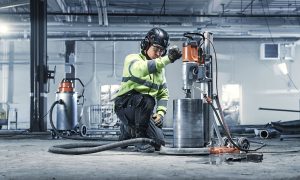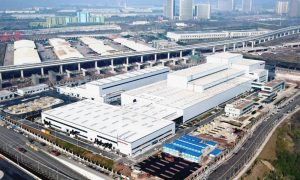How machinery is shaping the future of construction
Machinery innovations are changing construction and the industry is projected to see a surge in demand for environmentally friendly equipment, says Jeff Bennett, GM, MEA, Husqvarna Construction

The world is evolving faster than ever before. Today, 55% of the global population live in urban areas and this figure is projected to reach 68% by 2050, giving rise to the need for affordable housing as well as social, transportation and utility infrastructure.
According to the global forecast for the construction industry, over 60% of global construction activity will be undertaken in emerging markets by 2025, up from 35%. The volume of construction output will grow by more than 70% to $15 trillion worldwide by 2025, with an expansion rate of 3.6% every year between 2018 and 2022. Additionally, by 2050, experts suggest that there will be two billion additional city dwellers and hence sustainable urbanisation will pose a major construction challenge and the industry must strive to find innovative new products and solutions, to contribute to building better cities.
The construction industry plays a significant role in the Middle East region’s economic development. In 2018, $101.8bn worth of projects were awarded across the GCC, which went up to $102.3bn in 2019.
Pre-Covid, an upside was anticipated on growth prospects, primarily driven by significant investment in infrastructure and major capital projects across key sectors, such as hospitality, entertainment, education, and healthcare. The muted growth of the sector is reflective of the economic impact of the pandemic-linked lockdowns. The construction equipment industry, which depends highly on GDP growth and economic activity, faced the same headwinds as other industrials during the pandemic.
The global construction equipment market size is projected to reach $205bn by 2025, from an estimated value of $169.3bn in 2020, growing at 3.9% CAGR. The increasing number of infrastructure projects and mega construction projects are anticipated to further fuel the demand for construction equipment during the forecast period.
Advancements in construction machinery are mainly focused on equipment that will help drive change in the industry with more environmentally friendly and efficient ways of working. Operator-centric solutions focused on improving the health and safety of construction professionals will be a norm at future construction sites.
Battery powered construction products are examples of such advancement, causing less damage to the environment and driving up efficiency. Secondly, dust and slurry management solutions, as well as remote controlled machinery that keeps the operator safe and healthy, are revolutionising the construction industry and offering countless benefits to companies and their customers around the world. As the pandemic begins to abate, businesses are looking at robust technology models that will help with planning and implementing construction activities keeping the health and safety of their employees as the top priority. Hence, construction equipment is facing a very different landscape, when exploring the next normal for the industry.
Commercial, residential and infrastructure construction projects depend heavily on equipment such as cutters, dozers, excavators and wheeled loaders. To date, these machines have almost exclusively been diesel-powered, with some that can plug into the mains, with the hazard of a trailing cable. Also, cutting, drilling, grinding and demolishing concrete, brick and other hard construction materials creates dust and slurry.
Construction dust can cause serious damage to health and some types can eventually even lead to death. Regularly inhaling dust over a long period can cause life-threatening lung diseases. Moreover, dust also has a significant impact on tools, substantially reducing their operational life span. But with the advent of new technology, more and more companies will rely on battery-powered and eco-friendly equipment on construction sites, taking advantage of rapid improvements in the lightweight and powerful lithium-ion battery technology. These battery-powered machines are no less powerful or productive in comparison to traditional diesel models and since the usage of these machines is free from direct emissions and smoke, companies can gain a competitive advantage and demonstrate sustainable construction methods.
For the dust particles hovering in the air at construction sites, it is important to always use work methods for safe and efficient dust control that catch dust at the source and prevent it from becoming airborne. The industry is moving towards using high-quality professional dust control equipment and personal protective equipment that can catch even the smallest silica particles. These compact, lightweight machines are equipped with one, two or three powerful, single-phase electric motors with separate cooling, capable of running continuously all workday. This makes them suitable for all construction and restoration jobs, as well as for use with electric power tools. For instance, the Husqvarna A-line includes the most advanced and versatile portable air cleaners that extend from the tool itself through to the vacuum removal. This improves workplace safety, regardless of whether it is concrete dust, fine sanding dust or gypsum dust, while aiding in legal compliance.
Research shows that battery operated machinery can be economically viable for the construction industry. The benefits are endless. Not only do they provide better manoeuvrability, flexibility and safety, the benefits of battery-powered construction equipment also provide businesses with smart tools that are efficient, accurate and speedy for all employees. According to ‘The Future Home Report’ by Eurocell’s, 49% of consumers responded that they would be more likely to buy or rent an eco-conscious home, putting the pressure on construction companies to emit less, pollute less and build the world we want to live in, in a sustainable manner.
The innovations in this industry clearly represent advancement. In the near future, the industry will witness a surge in demand for battery-powered machinery, which will expand their share in the market as both environmentally friendly and economically sustainable solutions for construction equipment.


























